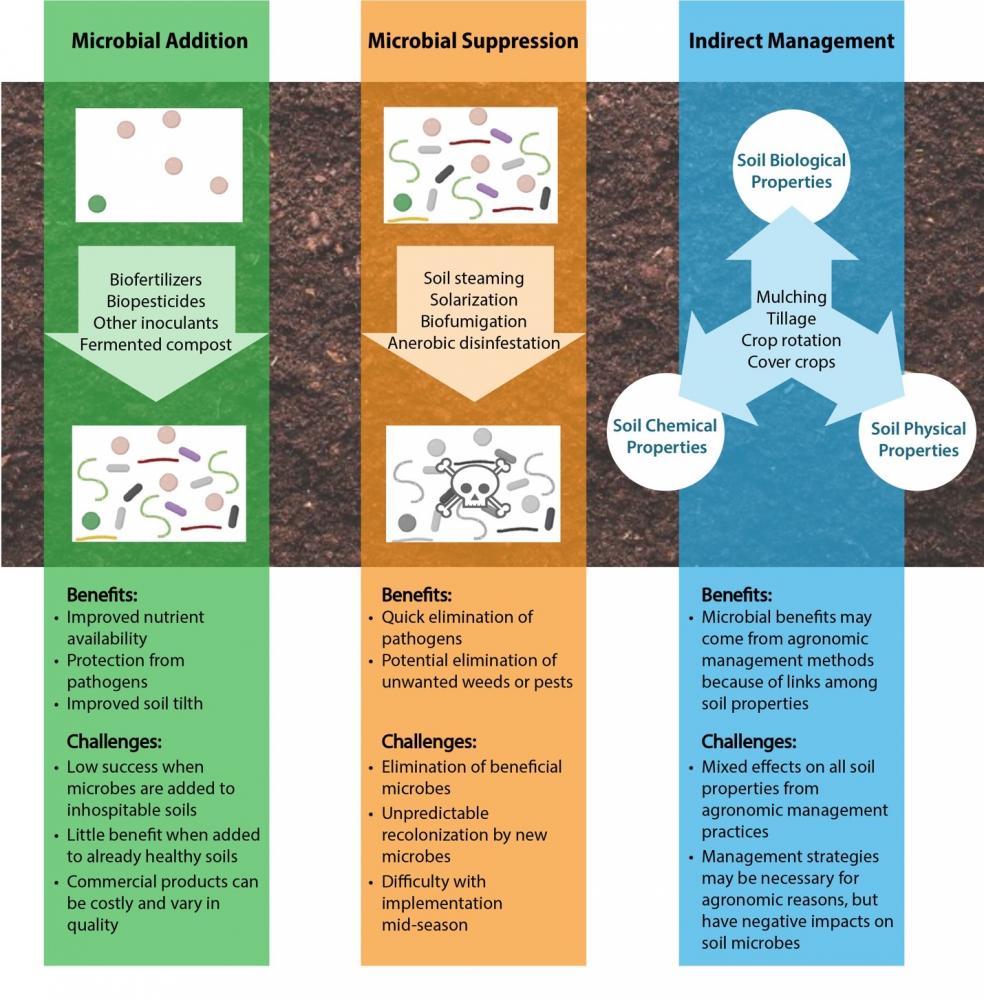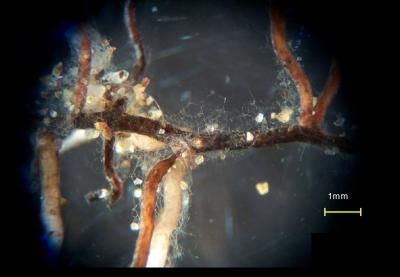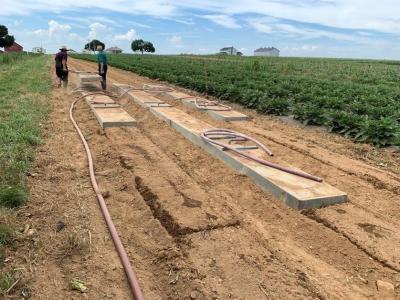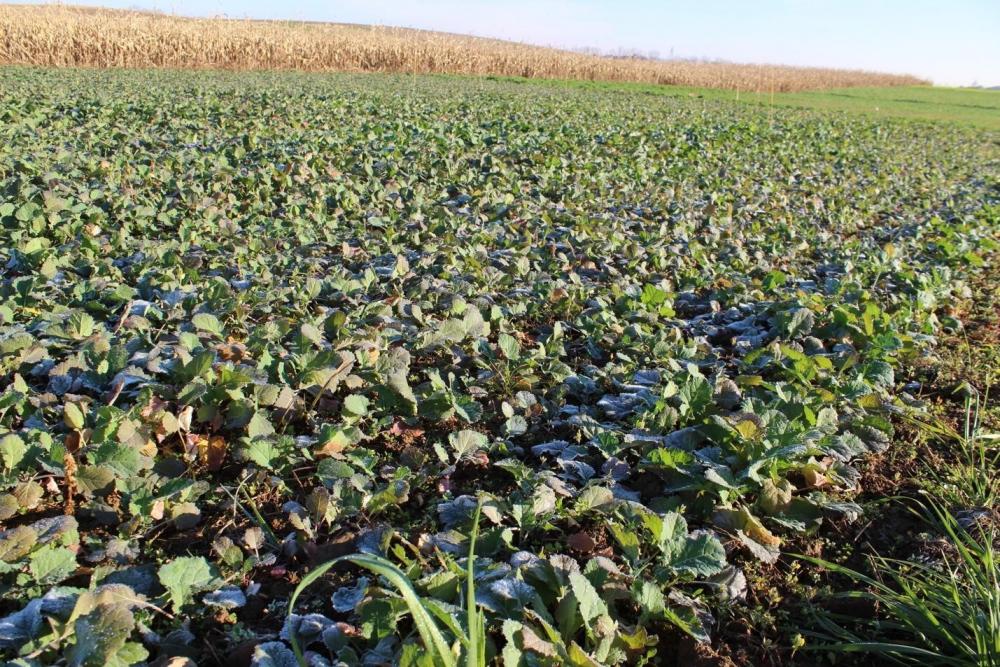eOrganic authors:
Sarah Isbell, Pennsylvania State University
Suzanne Fleishman, Pennsylvania State University
Mara Cloutier, Pennsylvania State University
Laura Kaminsky, Pennsylvania State University
Kristy Borrelli, Pennsylvania State University
Terrence Bell, Pennsylvania State University
Introduction
The biological component of soil is important for soil health, particularly on organic farms where biological soil functions cannot be replaced by synthetic additives. A soil biological community encompasses all of the living things in the soil, including earthworms, insects, nematodes, plant roots, animals, and microbes. Soil microbes (bacteria, fungi, and archaea) perform fundamental functions in soils, such as cycling of crucial nutrients like nitrogen and carbon, breaking down crop residues, and stimulating plant growth. Not all microbial contributions are beneficial—pathogenic microbes negatively impact crop health and yield, and in the worst instances can lead to total crop failure. While the important role of microbes in soil health and crop performance is clear, the microbial component of soil is arguably the hardest to observe and to manage.
It is standard practice for farmers to directly manage the chemical and physical properties of soil (e.g., soil structure, pH, nutrient content), but successfully managing the biological component of soils—specifically, the microbial component—presents several challenges. Microbes are too small to be seen or quantified without specialized equipment, and many are not easily captured or even identified. Furthermore, microbial communities and the agronomic functions that they perform are dynamic, complex, and not easily interpreted for field practices. Still, microbial management has the potential to make the investment worthwhile, especially in organic agricultural soils that rely on microbes for provision of nutrients, decomposition of organic materials, and biocontrol.
This article will briefly introduce strategies used by organic farmers to manage the microbes that live and grow in their soil systems. These management strategies range from adding known beneficial soil microbes to suppressing harmful soil microbes (Fig. 1). These approaches also range in cost, labor and equipment needs, scale of application, and measurable efficacy. Additionally, we present common crop management practices that, while targeting other agronomic needs, also impact soil microbial communities.

Figure 1. Benefits and challenges of strategies for managing microbes in organic agricultural soils.
Microbial Addition
For multiple reasons, farmers may directly add microbes to their soils. These added microbes can, in theory, aid in nutrient availability (biofertilizers or biostimulants), pest suppression (biopesticides), or stimulation of plant growth through hormone signaling (plant growth promoters [PGPs]; or also biostimulants). Through microbial additions, farmers may seek to enhance the proportion of beneficial microbes in their soils, introduce specific microbes directly linked to benefit a particular crop, or introduce specific microbes directly linked to enhancing nutrient availability.
Farmers can add microbes to their soils using commercial products designed for specific functions, or can generate their own on-farm microbial mixtures for a less targeted approach. Certified organic farmers must ensure that any commercial product used in their operation is approved as an organic input by a third-party review agency. Note that OMRI and WSDA lists are good places to identify potentially useful products, but all products that you use must be approved by your certifier. For more information on how to determine whether an input can be used on your farm, see the article, Can I Use This Input On My Organic Farm?
Commercial Microbial Inoculants
Various companies collect, grow, and package soil microorganisms, which are then marketed as products to augment or add beneficial microbes to soils. Such products can be added to soils through a variety of well-established approaches (e.g., in furrow, as seed coatings, or applied directly to roots). These inoculants may include a single microbial species or a mixture of species that can be added to organic agricultural soils.
One of the most common types of commercial inoculant contains microbes that form symbiotic relationships with plants. In these relationships, a plant will provide specific benefits to microbes, such as food for the microbes in the form of sugars, in exchange for resources from the microbe, such as nutrients or water. For example, legumes form nodules on their roots to house rhizobia bacteria; the bacteria fix nitrogen from the atmosphere and provide it to the plant, while the plant provides sugars and an ideal environment for the rhizobia to live within. These inoculants may be added to the soil directly or as a seed coat at planting. Inoculation with rhizobia bacteria for legume crops is not only the most common, but the most well-researched and clearly beneficial application of microbial inoculation. Specifics of legume inoculation are discussed in more detail in Legume Inoculation for Organic Farming Systems (Grossman, 2019).
Mycorrhizal fungi are also commonly added to soils as inoculants. These fungi live partially within roots and partially in the soil (Fig. 2). They access soil resources such as nitrogen and phosphorus, which they then transfer to the plant. The primary types of mycorrhizal fungi that form relationships with agricultural plants are arbuscular mycorrhizal fungi (AMF). Commercial inoculants with AMF frequently contain species of Glomus. While AMF may primarily benefit plants through increasing phosphorus uptake, water and nitrogen may also be transferred from the fungi in smaller amounts. There are documented successes with AMF inoculation, including a study on over 200 field trials that found an increase in potato yields on fields with AMF applied (Hijri, 2016). One important takeaway from this study is that AMF inoculation can be effective across many sites. However, this study saw high variability of the effect of AMF inoculation.

Figure 2. Arbuscular mycorrhizal fungi (AMF) hyphae in a symbiotic relationship with grapevine roots. Photo credit: David Eissenstat, Pennsylvania State University.
There are also commercial products that contain free-living soil microbes. These are bacteria and fungi that live outside of plant roots, but still promote plant growth and health, and/or suppress microbes that have a negative effect on plant growth and health (i.e., pathogens). For example, some microbes that fix nitrogen can live in soil very close to plant roots and may provide nitrogen to crops. Other free-living microbes may release anti-fungal or anti-pathogenic compounds, which may protect nearby plants from those pathogens, or may release toxins that kill nematodes or other soil pests. Phosphorus-solubilizing bacteria are another common commercially-available product.
When selecting a commercial microbial product, it is important to consider that quality control for living microorganisms is more difficult than it is for other farm amendments. The shelf-life of microbial products tends not to be much longer than a year before microbial viability starts to decrease, and is substantially less than some products. Furthermore, farmers should review the soil conditions under which the product is effective to make sure it is an appropriate choice for their farm. Generally, farmers should seek targeted solutions to specific issues in their soils and be skeptical of any microbial product that claims to be a cure-all. In certain scenarios, microbial inoculants may not be appropriate or beneficial. For example, if soils already have ample nutrients that are plant-available, microbial biofertilizers may not improve crop nutrient uptake or yield. Moreover, the complex nature of microbial interactions makes it very difficult to predict when and where commercial products will be effective. Finally, there are categories of commercial microbial inoculant that remain untested, and their benefits are less clearly demonstrated or not demonstrated at all.
Non-Commercial Microbial Sources
The addition of microbes to soils from a non-commercial source may appeal to growers striving for closed-loop approaches with few off-farm inputs. Microbes can be introduced to soils through additives that are intended primarily as a microbial inoculant, but also through additives that have another primary purpose. For example, compost, vermicompost, and manure are typically added to introduce nutrients, with the secondary purpose of adding beneficial microbes to soils. Other additives that are often made on-farm include fermented starch water, fermented mixed-compost (a staple of Korean natural farming), and compost tea. These additives may be used for multiple potential benefits but are largely aimed at building and augmenting beneficial soil microbial populations.
In general, microbial communities that are generated on-farm will be mixtures of species that are unknown to the farmer. This means that while these additions may include beneficial microbes that act as biofertilizers, biopesticides, biostimulants, or PGPs, they could also include pathogens or microbes that provide no obvious benefit to soil health or crop yield. As with commercial inoculants, the complexity of microbial interactions in on-farm generated products makes it difficult to predict when and where products will be beneficial to soil health, crop health, or crop yields.
It is important to note that unknown combinations of microbes are constantly being introduced to farmed soils from sources such as dust, precipitation, plant litter, and animal droppings. Especially under conditions where a soil is depleted of beneficial microbes (such as after a microbial suppression treatment), introducing microbes may be as simple as exposing the soil to outside air or mixing in soil from a nearby open field.
Microbial Suppression
Whereas beneficial microorganisms have the capacity to enhance crop growth, the presence of certain soil microbial pathogens can lead to total crop failure. When pathogens are of substantial concern, farmers may approach mitigation through blanket approaches that aim to extinguish harmful, neutral, and beneficial microorganisms, as the damage caused by the pathogens may outweigh the benefits provided by other soil organisms.
In non-organic agriculture, blanket soil microbial clearing may be approached through application of chemical pesticides, or in rare cases, soil fumigation. A commonly used fumigant, methyl bromide, has mostly been phased out (Johnson et al., 2012). For organic farmers, other approaches may be considered, including soil steaming (Fig. 3), anaerobic disinfestation (Shrestha et al., 2014), solarization (Masabni and Franco, 2016), or biofumigation with primarily brassicas (Fig. 4) (Rudolph, 2016). The degree to which these approaches eradicate microorganisms from soils varies. Certain microorganisms can resist even extreme stresses by forming spores, going dormant, or simply through avoidance (e.g., surviving within soil aggregates that are less impacted by the applied treatment).
Even when microorganisms are effectively suppressed from a treated soil, the now-depleted soil landscape offers a buffet of resources to incoming microbes, which includes nutrients released by the microbes that were killed off. Some microbes will quickly repopulate the soil within days or weeks—for example, strains of Bacillus can use locomotion to move rapidly through soil if it is sufficiently saturated. Other microbes will be deposited from outside sources like rain, dust, and animal droppings. If a microbial suppression treatment was intended to kill pathogens, and those pathogens continue to survive nearby or below the treated soil, they may still present a near-term challenge. In general, this approach should be considered to have disruptive impacts on soil health, as it will alter soil physical and chemical properties as well as microbial life. Although pathogen elimination is critical under some scenarios, soil clearing should be avoided if possible.
Some farmers may follow microbial clearing with microbial additions. For example, they may choose to amend cleared soils with compost or other sources of beneficial microbes, as mentioned above. If neutral or beneficial microorganisms repopulate cleared soils, it could help limit the establishment of undesirable microbes, as the introduced microbes occupy available space and resources. Unfortunately, it is very hard to know how any particular microbial source will impact the composition and performance of microbes in the amended soil. Some key microbes may need to be reintroduced; for instance, AMF are not typically quick dispersers, so targeted reintroductions may yield clear benefits.

Figure 3. Soil steaming in the field for removal of microbes on a Pennsylvania farm. Photo credit: Jeff Graybill, Pennsylvania State University.

Figure 4. Brassica monoculture cover crops can be used for biofumigation. Photo credit: Catalina Mejia, Cornell University.
Indirect Management: Other Soil Management Strategies with Microbial Impacts
Soil management practices aimed at achieving other agronomic goals will also impact soil microbial communities. In fact, these management practices likely represent the predominant ways that farmers influence soil microbes. Examples include tillage, crop rotation, mixed cropping and underseeding, cover cropping, and using organic mulches. The impacts of these practices on soil microbes are important to consider, especially when building a farm system that also includes microbial additions or strategies for microbial suppression. However, predicting the overall response of the soil microbial community to these practices is challenging.
Soil disturbances and additions of carbon and nutrients to the soil (i.e., through additions of organic fertilizer, decomposing plant material, or living roots) may influence the total microbial quantity (measured as microbial biomass), microbial diversity, and the functions of the microbial community. They may also impact the quantity or function of distinct microbial groups. Another consideration is the agricultural history of farmland, which can be important if there are legacy effects from past soil management or pest control strategies. For instance, if there is a surplus of mineral phosphorus in the soil due to a long history of phosphorus additions, adding or promoting phosphorus-solubilizing microbes may have positive impacts on phosphorus availability to crops.
The relationships between soil physical, chemical, and biological properties are interdependent and complex. Consequently, soil management strategies can simultaneously improve all of these soil components or result in a mixture of benefits and drawbacks. Pinning down the impacts of broad soil management on microbial communities is a challenge and is currently an active topic of research. In addition to soil management, many other factors influence the physical, chemical, and biological properties of the soil, including soil type, climate, crop type, and land use history.
Considerations for Management and Future Outlook
Microbial management practices can be measurably successful in helping to achieve specific goals. However, any intervention can yield complex and unintended consequences. Whether approaches to influence microbial populations are direct or indirect, it can be difficult to assess if these actions have had the intended impact. With microbial management, as opposed to other elements of organic agricultural systems, farmers have few tools available to monitor the direct impacts of their interventions. In fact, researchers and agricultural professionals are still lacking conclusive benchmarks for describing a complex microbial community as "good" or "bad" in a farm system. Given the potential benefits and challenges of microbial management strategies, the following are a few important considerations:
- Microbes play important roles in plant and soil health and can cause dramatic differences in yield, ranging from an increase in crop productivity to total crop loss.
- Soil microbial interventions may have positive, neutral, or negative consequences in a farming system, but current research has not yet optimized microbial contributions to soil systems.
- The degree to which managing soil microbes will impact soil or plant health is likely dependent on the composition and activities of the microbes that are already in the soil, as well as other soil characteristics.
- Growers may decide to use low-cost methods as a standard practice, such as simply ventilating a greenhouse to reintroduce microbes following soil sterilization, but are encouraged to be more selective with time-intensive or financially-intensive practices, such as using commercial inoculants.
- Small trials on farms can ensure that a specific management practice has its intended impact, since site-dependent factors may determine whether microbes will establish in the soil and perform the intended function. The effects of some practices and products on individual farms may become clear from monitoring the soil and crops.
- Pathogens, other microbes with negative impacts, or microbes with neutral impacts can be introduced to a system along with beneficials. For example, it is possible for cover crops to support not just beneficial microbes, but also those that are not specifically beneficial for the target crop. Similarly, increasing microbial diversity does not necessarily result in an increase in positive services from soil microbes.
- Soil building practices like adding compost, growing cover crops, and reducing soil disturbance have overall beneficial impacts on soil biological communities and are encouraged to build soil health on the farm.
With the increasing interest in managing soil microbes by both growers and researchers, we expect to see more microbial products and professional recommendations in the coming years. Researchers are increasingly testing the efficacy of commercial products and microbially-focused management practices. Many practices that target microbes and are popular with growers such as farmscaping, Korean natural farming, or biodynamic farming still have little conclusive research. There may also be new uses of microbes that become apparent, such as microbes that promote plant drought tolerance or resistance to heat stress.
*IMPORTANT: Before using any pest control product in your organic farming system:
- Read the label to be sure that the product is labeled for the crop and pest you intend to control, and make sure it is legal to use in the state, county, or other location where it will be applied.
- Read and understand the safety precautions and application restrictions.
- Make sure that the brand name product is listed in your Organic System Plan and approved by your USDA-approved certifier. If you are trying to deal with an unanticipated pest problem, get approval from your certifier before using a product that is not listed in your plan—doing otherwise may put your certification at risk.
Note that OMRI and WSDA lists are good places to identify potentially useful products, but all products that you use must be approved by your certifier. For more information on how to determine whether a pest control product can be used on your farm, see the article, Can I Use This Input On My Organic Farm?
References and Citations
- Grossman, J. 2019. Legume inoculation for organic farming systems [Online]. eXtension Foundation, eOrganic Community of Practice. Available at: https://eorganic.org/node/4439 (verified 7 Apr 2021).
- Hijri, M. 2016. Analysis of a large dataset of mycorrhiza inoculation field trials on potato shows highly significant increases in yield. Mycorrhiza 26:209—214. (Available online at: https://doi.org/10.1007/s00572-015-0661-4) (verified 7 Apr 2021).
- Johnson, J. A., S. S. Walse, and J. S. Gerik. 2012. Status of alternatives for methyl bromide in the United States. Outlooks on Pest Management 23:53—58. (Abstract available online at: https://doi.org/10.1564/23apr02) (verified 7 Apr 2021).
- Shrestha, U., A. L. Wszelaki, and D. M. Butler. 2014. Introduction to anaerobic soil disinfestation as a fumigant alternative. UT Extension Publication SP 765-A, University of Tennessee Institute of Agriculture. (Available online at: https://extension.tennessee.edu/publications/Documents/SP765-A.pdf) (verified 7 Apr 2021).
- Masabni J. G., and J. G. Franco. 2016. Soil solarization [Online]. Texas A&M AgriLife Extension. Available at: https://agrilifeextension.tamu.edu/library/gardening/soil-solarization/ (verified 7 Apr 2021).
- Rudolph, R. 2016. What is biofumigation and does it have potential to be used in Pacific Northwest red raspberry production systems? [Online]. Whatcom Ag Monthly Volume 5 Issue 4, Washington State University Extension. Available at: https://extension.wsu.edu/wam/what-is-biofumigation-and-does-it-have-potential-to-be-used-in-pacific-northwest-red-raspberry-production-systems/ (verified 7 Apr 2021).
Additional Resources
- Gaskin, J. W., P. Hartel, E. Little, and G. Harris. 2013. Soil inoculants [Online]. University of Georgia Extension, Circular 990. Available at: https://extension.uga.edu/publications/detail.html?number=C990&title=Soil%20Inoculants (verified 7 Apr 2021).
- Park, S., S. Cao, and B. B. McSpadden Gardener. 2010. Inoculants and soil amendments for organic growers [Online]. Ohioline, Ohio State University Extension. Available at: https://ohioline.osu.edu/factsheet/SAG-17 (verified 7 Apr 2021).



